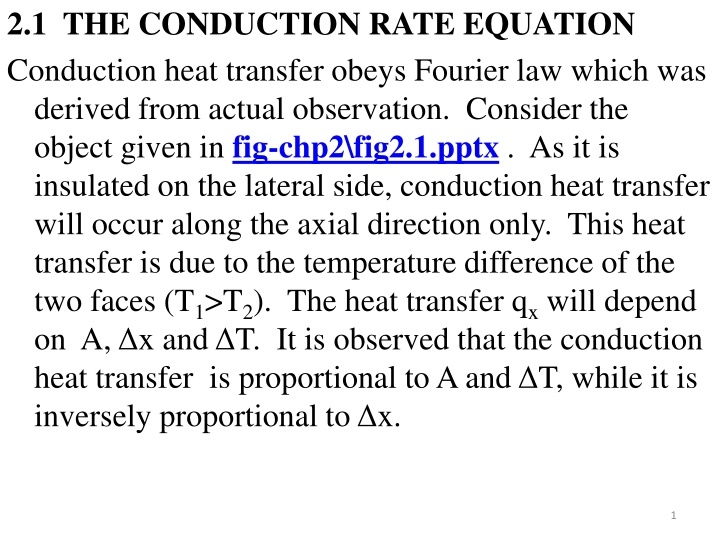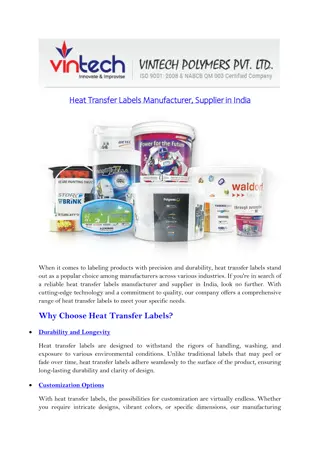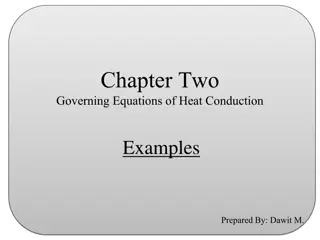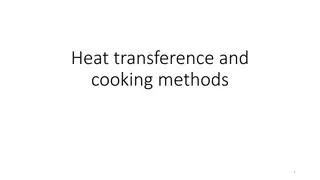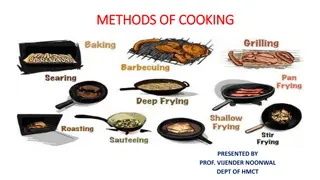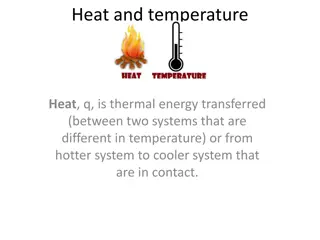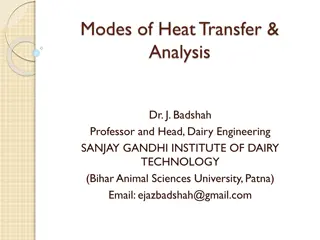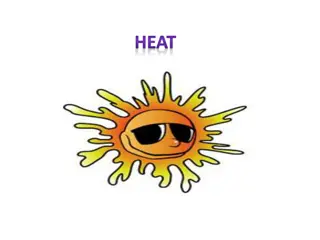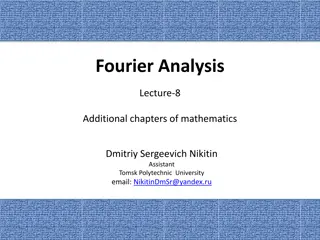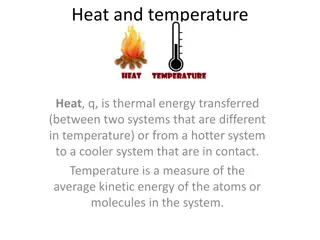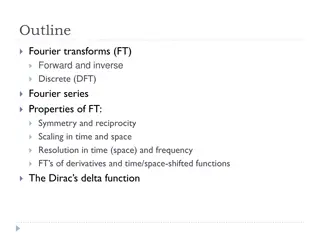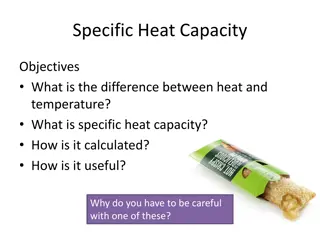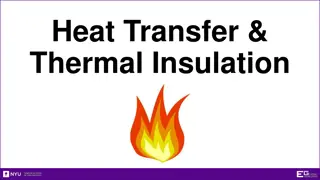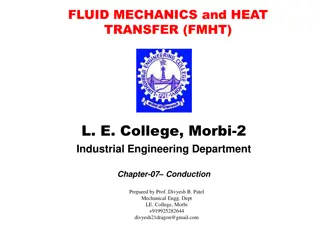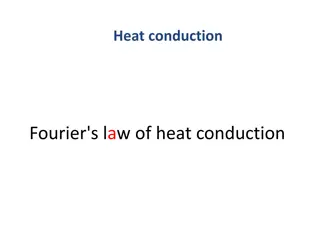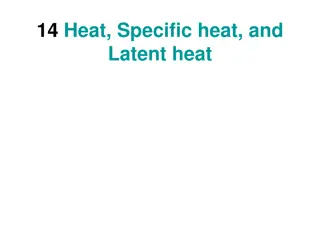Conduction Heat Transfer and Fourier's Law
Conduction heat transfer follows Fourier's law, expressing the relationship between heat transfer, area, temperature, and distance. Thermal conductivity is a key property influencing energy diffusion. Fourier's law can be extended to three dimensions and isotropic materials. Thermal conductivity varies between solids, liquids, and gases, impacting heat transfer capabilities significantly.
Uploaded on Mar 12, 2025 | 0 Views
Download Presentation

Please find below an Image/Link to download the presentation.
The content on the website is provided AS IS for your information and personal use only. It may not be sold, licensed, or shared on other websites without obtaining consent from the author.If you encounter any issues during the download, it is possible that the publisher has removed the file from their server.
You are allowed to download the files provided on this website for personal or commercial use, subject to the condition that they are used lawfully. All files are the property of their respective owners.
The content on the website is provided AS IS for your information and personal use only. It may not be sold, licensed, or shared on other websites without obtaining consent from the author.
E N D
Presentation Transcript
2.1 THE CONDUCTION RATE EQUATION Conduction heat transfer obeys Fourier law which was derived from actual observation. Consider the object given in fig-chp2\fig2.1.pptx . As it is insulated on the lateral side, conduction heat transfer will occur along the axial direction only. This heat transfer is due to the temperature difference of the two faces (T1>T2). The heat transfer qxwill depend on A, x and T. It is observed that the conduction heat transfer is proportional to A and T, while it is inversely proportional to x. 1
The collective effect can be represented by T = = q A T T T x 1 2 x The above can be written as an equation using a proportionality constant k, thermal conductivity (W/m.K) which is a property of the substance T kA qx = = x To evaluate the heat transfer at any location x, needs an imposition 2
limit x0 which gives dT kA q x = (2.1) ( ) W dx q dT = = ' ' x 2 (2.2) ( / ) x q k heat flux W m A dx The negative sign is necessary as the slope dT/dx is negative since heat is always transferred in the direction of decreasing temperature. is directional and normal to the isothermal surface having a positive value. " x q 3
Fouriers law can be generalized in three dimensional representation as T dy dx T T = + + = " q i j k (2.3) - ( ) - k k T dz Where is del operator The heat flux vector is in a direction normal to the isothermal fig-chp2\fig2.2.pptx . As an alternative fig-chp2\fig2.3.pptx T k qn = " (2.4) n 4
The heat flux vector can be resolved as j j i i + = k k + " " x " y " z (2.5) q q q q T T T = = = ' ' ' ' ' ' (2.6) q k q k q k x y z x y z All the above require the assumption that the thermal conductivity k does not vary with x, y, or z. Such substances are called isotropic. 5
2.2 THERMAL PROPERTIES OF MATTER Thermal conductivity is a transport property on which energy transfer by diffusion depends on. From Fourier s law ' ' q k x x = ( / ) T x Similar definitions follow for ky and kz. For isotropic materials kx = ky = kz = k. fig-chp2\fig2.4.pptx gives the ranges of k values. In general, the thermal conductivity of a solid is larger than that of a liquid, which is larger than that of a gas. 6
2.2.1 The Solid State Solids-comprised of electrons and atoms bound in a lattice. Transport of thermal energy due to a) migration of free electrons 2) lattice vibrational waves when quantized are termed as phonons analogous to photons of electromagnetic waves. Pure metals-electron contribution to conduction heat transfer dominates. Non-conductors-the phonon contribution is dominant. According to kinetic theory 1 = (2.7) k C c mfp 3 7
For conducting materials CCe, electron specific heat per unit volume, , mean electron velocity, mfp e, electron mean free path. Collision is either with an imperfection or with a phonon. In non- conducting solids C Cph, phonon specific heat, - average speed of sound and mfp ph , phonon mean free path. Thermal conductivity increases as the mean free path of the energy carriers (electrons and phonons) is increased. When both (electrons and phonons) are considered k=ke + kph (2.8) k e c c 1 : electrical resistivit y e e Pure metals-low e, ke is much larger than kph. 8
Non-metallic solids-k is determined primarily by kph. Crystalline (well ordered) materials like quartz have high kph. Temperature dependence of k for some selected solids is shown in fig-chp2\fig2.5.pptx . The analysis becomes more complex when the material s characteristic dimensions are of the order of microscale and nanoscale. 2.2.2 The Fluid State Includes both liquids and gases. Intermolecular spacing is much larger Motion of molecules is more random 9
Due to the above reasons thermal energy transport is less effective. k for gases and liquids is lower. According to kinetic theory of gases 1 = vc c (2.9) k mfp 3 For gases k increases with increasing temperature and decreasing molecular weight (same as )as shown in fig-chp2\fig2.6.pptx . Because and mfp are directly and inversely proportional to the gas pressure, k is independent of pressure except in extreme cases (perfect vacuum). c 10
Physical mechanisms for explaining thermal conductivity in liquids are not well understood. fig-chp2\fig2.7.pptx shows the dependence of k on temperature on selected nonmetallic liquid. 2.2.3 Insulation Systems Consist of low thermal conductivity materials combined to achieve an even lower system thermal conductivity. Conventional forms are fiber-, powder-, and flake-type insulations, where the solid material is finely dispersed throughout the air space. If small voids or hollow spaces are formed by bonding portions of the solid material, a rigid matrix is formed. Foamed systems are typical examples. 11
Reflective insulations are composed of multilayered, parallel, thin sheets or foils of high reflectivity. 2.2.4 Other Relevant Properties These are in general called thermophysical properties classified as transport and thermodynamic properties. The transport properties are the ones that have direct effect on momentum, heat and mass transfer. These are thermal conductivity, k (for heat transfer), kinematic viscosity, (for momentum transfer), and diffusion coefficient, D(for mass transfer). Extensively used thermodynamic properties are the density, , and specific heat, cp. The product cp12
(J/m3) is the volumetric heat capacity. It measures the ability of a material to store thermal energy. A very important property termed as thermal diffusivity and designated by is given by k 2 = ( / ) m s c It measures the ability of a material to conduct thermal energy relative to its ability to store thermal energy. Large has quick response to environmental temperature change. 13
2.3 HEAT DIFFUSION EQUATION 2.3.1 Rectangular Coordinates Major objective in conduction analysis is to determine the temperature field T(x,y,z) in a medium resulting from conditions imposed within or on its boundary. This can help to determine heat flux Magnitude of temperature at locations of interest for determination of thermal stresses, expansions, and deflections etc.. A differential approach is used to derive the 14
governing differential equations by using a homogeneous differential control volume shown in fig-chp2\fig2.8.pptx . Neglecting higher order terms in Taylor series, heat transfers across opposite faces can be approximated by dx x + = + q = + (2.10a) x q q + x dx x q y (2.10b) q q dy y dy y y q = + (2.10c) z q q dz + z dz z z 15
energy generated due to internal energy source: dz dy dx q Eg = ' ' ' (2.11) ' ' 'q where is energy generation rate per unit volume, W/m3. Energy storage rate in the differential volume is ) ( T E = = = ( ) c Tdm c TdV c dx dy dz st P P P t t t (2.12) Applying conservation of energy requirement E E E E + + = = + + in g out st 16
Substituting the corresponding expressions dx q q q q z y x + + + ( = + + ' ' ' ) dy dz q q q + + + x dx y dy z dz T + (2.13) c dx dy dz P t Using Taylor s approximation + + = = + + q q q y x z = = + + = = + + q q dx q q dy q q dz + + + + x dx x y dy y z dz z x y z Substitution in 2.13 gives q q q T y ' ' ' x z + + = = dx dy dz q dxdydz c dxdydz p x y z t 17
Using Fouriers law T T T T = = = = = = = = q kA ( k dydz ) ; q kA ( k dxdz ) x x y y x x y y T T = = = = q kA ( k dxdy ) z z z z After substitution in the energy balance equation will result in 18
T T T + + k k k dx dy dz x x y y z z T + = ' ' ' (2.14) q dx dy dz c dx dy dz P t Division by dV=dx dy dz gives T T T T + + + = ' ' ' k k k q c P x x y y z z t (2.15) 19
In vector form, the above equation becomes = + ) T ( . . T ' ' ' (2.16) k q c P t The above is the heat diffusion equation whose solution gives T(x,y,z,t) For constant k, the equation simplifies to q z y x = + 2 2 2 ' ' ' 1 T 2 T 2 T 2 T + + + = (2.17) k t ' ' ' 1 q T 2 (2.18) T k t k thermal diffusivity P c = where 20
Under steady statecondition (T/t=0), the general equation (2.15) reduces to T T T + + + ' ' '= q (2.19) 0 k k k x x y y z z For a one-dimensional heat transfer with no heat generation the above equation reduces to d dT = (2.20) 0 k dx dx With no heat generation, steady state assumption gives dq x 0 = = " " (2.21) tan x or q cons t dx 21
EXAMPLE 2.1 The temperature distribution across a wall 1 m thick at a certain instant of time is given as T(x) = a + bx + cx2 Where T is in oC and x is in meters, while a=- 900oC, b= -300oC/m, and c = -50oC/m2. A uniform heat generation, is present in the wall of area 10 m2 having the properties = 1600 kg/m3, k = 40 W/m.K, and cP = 4 kJ/kg.K. 1. Determine the rate of heat transfer entering the wall (x=0) and leaving the wall (x=1m). 2. Determine the rate of change of energy storage in the wall ' ' '= = 3 q 1000 W / m , 22
3. Determine the time rate of temperature change at x = 0, 0.25, and 0.5 m. SOLUTION 1. Incoming and outgoing heat transfer rate T = = = = = = + + q q ) 0 ( x kA kA b ( 2 cx ) = = in x 0 x = = @ x 0 = = = = = = = = q bkA 300 x 40 10 x 120000 W 120 kW in T = = = = = = + + q q ( L ) kA kA b ( 2 cx ) = = out x x L x = = @ x L = = + + = = [ + + q b ( 2 cL ) kA = = 300 ( 2 50 ) ] 1 x 40 x 10 out = = 160000 W 160 kW 24
2. Rate of change of energy storage can be determined from ; E E E E st out g in + + = = E + + = = = = ' ' ' q AL g E 120 1000 ( 10 x / ) 1 x 1000 160 st = = E 30 kW st 3. Rate of temperature change at any location = = 2 ' ' ' T k T q + + 2 t c x c P P 25
From the given temperature distribution T x x 2 T = = = = + + = = = = = = o 2 b ( 2 cx ) 2 c ( 2 50 ) 100 C / m 2 x x which is a constant (independent of location). T 40 1000 = = + + = = + + 4 4 ( 100 ) . 6 25 10 x . 1 56 10 x t 1600 x 4 1600 x 4 = = 4 o . 4 69 10 x C s / This temperature decrease rate is the same at any location. 26
2.3.2 Cylindrical Coordinates When the heat transfer problem involves cylindrical objects such as pipes, the equation in cylindrical coordinates will be more convenient for analysis. Referring to fig-chp2\fig2.9.pptx ( k q r + + = = + + + + T T T = = = = = = r ( k q ( k rd dz ) dz dr ) q d dr ) r z r z q q q r r z = = + + = = + + q q dr q q rd q q dz + + r dr r d z dz z r r z = = dV rd dr dz 27
' ' ' ' ' ' E = = = = q dV q ( rd ) dr dz g c ( Tdm ) c ( T [ dV ]) T E P P = = = = = = drdz c [ rd ] st P t t t Using the energy balance equation E E E E + + = = in + + g + + out + + st + + + + ' ' ' q q q q ( rd ) drdz q ( q q ) + + + + + + r z r dr d z dz T = = c ( rd ) drdz P t 28
q q q T ' ' ' r z + + = = dr rd dz q ( rd ) drdz c ( rd ) drdz P r r z t Substitution of Fourier s law T dz krd r T T + + + + dr kdzdr rd krd dr dz r r r z z T ' ' ' + + = = q ( rd ) drdz c ( rd ) drdz p t After substitution and division by will give T k r r r r = = dV rd dr dz 1 1 T T T + + + = ' ' ' kr k q c P 2 z z t (2.22) 29
For constant k, the equation becomes ' ' ' 1 1 1 T T T q T + + + = r 2 r r r r z z k t (2.23) The same result would have been achieved if the del operator expressed in cylindrical coordinates had been used 2 2 1 1 r r r r 2 = + + (2.24) r 2 2 2 z 30
2.3.3 Spherical Coordinates If heat transfer involves spherical shapes then the conduction heat transfer equations in spherical coordinates will be convenient for analysis. The spherical differential control volume is shown in fig-chp2\fig2.10.pptx. If we directly use the Laplacian in spherical coordinates as 1 r 1 1 = + + 2 2 sin r 2 2 2 2 sin sin r r r r (2.25) 31
For constant k, the conduction equation in spherical coordinates becomes 1 1 1 T T T + + 2 sin r 2 2 2 2 sin sin r r r r r ' ' ' 1 q T + = (2.26) k t 32
Example 2.2 Passage of an electric current through a long conducting rod of radius ri and thermal conductivity kr results in uniform volumetric heating at a rate of . The conducting rod is wrapped in an electrically nonconducting cladding material of outer radius ro and thermal conductivity kc, and convection cooling provided by an adjoining fluid. For steady state conditions, write appropriate forms of the heat equations for the rod and cladding. Express appropriate boundary conditions for the solution of these equations. ' ' 'q 33
Solution Appropriate equation for the rod in cylindrical coordinates is given by 1 T + + ' ' '= = kr q 0 r r r For the cladding 1 T = = kr 0 r r r 35
Boundary conditions 1. By simple observation, the temperature distribution is symmetric in the rod. 2. Tr(ri) = Tc(ri) (intermediate temperature) 3. c c r r @ dr dr = = = = dT dT = = k k r r @ r r i i dT 4. c = = k [ h T r ( c ) T ] c o dr = = @ r r o 36
2.4 BOUNDARY AND INITIAL CONDITIONS The complete solution of the heat equation requires the state at the boundaries and if the situation is time dependent, initial condition will be required. Since the heat equation is a second order in spatial coordinates, two boundary conditions must be expressed for each coordinate needed to describe the system. As the equation is also first order in time, one initial condition must be satisfied. Three kinds of boundary conditions commonly encountered in heat transfer are: 37
1. Constant Surface Temperature:- The surface is maintained at a fixed temperature at any time. T(0,t) = Ts ( fig-chp2\fig2.11.pptx ) This is termed as Dirichlet condition or boundary condition of the first kind. This is closely approximated by surfaces in contact with phase changing fluids. 2. Constant Surface Heat Flux:- This heat flux related to the temperature gradient at the surface is expressed as T k ) 0 ( q = = = = = = ' ' x ' ' s q x @ x 0 38
This is termed as Neumann condition or boundary condition of the second kind. This may be realized by bonding a thin film electric heater to the surface or allowing solar radiation on the surface. A special case is a perfectly insulated surface, or adiabatic surface where ( T/ x)x=0 = 0. 3. Boundary condition of the third kind involves convective heat transfer at the surface (cooling or heating) expressed as T k 0 x @ = = = = [ h T t , 0 ( T )] x 39
Example 2.3 A long copper bar of rectangular cross-section, whose width w is much greater than its thickness L, is maintained in contact with a heat sink at its lower surface, and the temperature throughout the bar is approximately equal to that of the sink, To. Suddenly, an electric current is passed through the bar and an airstream of temperature T is passed over the top surface, while the bottom surface continues to be maintained at To. Obtain the differential equation and the boundary and initial conditions that could be solved to determine the temperature as a function of position and time in the bar. 40
Solution The appropriate equation is q x 2 ' ' ' T 2 1 T + + = = k t One initial condition and two boundary conditions are required to solve this PDE. IC: T(x,0) = To BC: 1) T(0,t) = To 2) ) t , L ( T [ h x L x @ = = T = = k T ] 42
